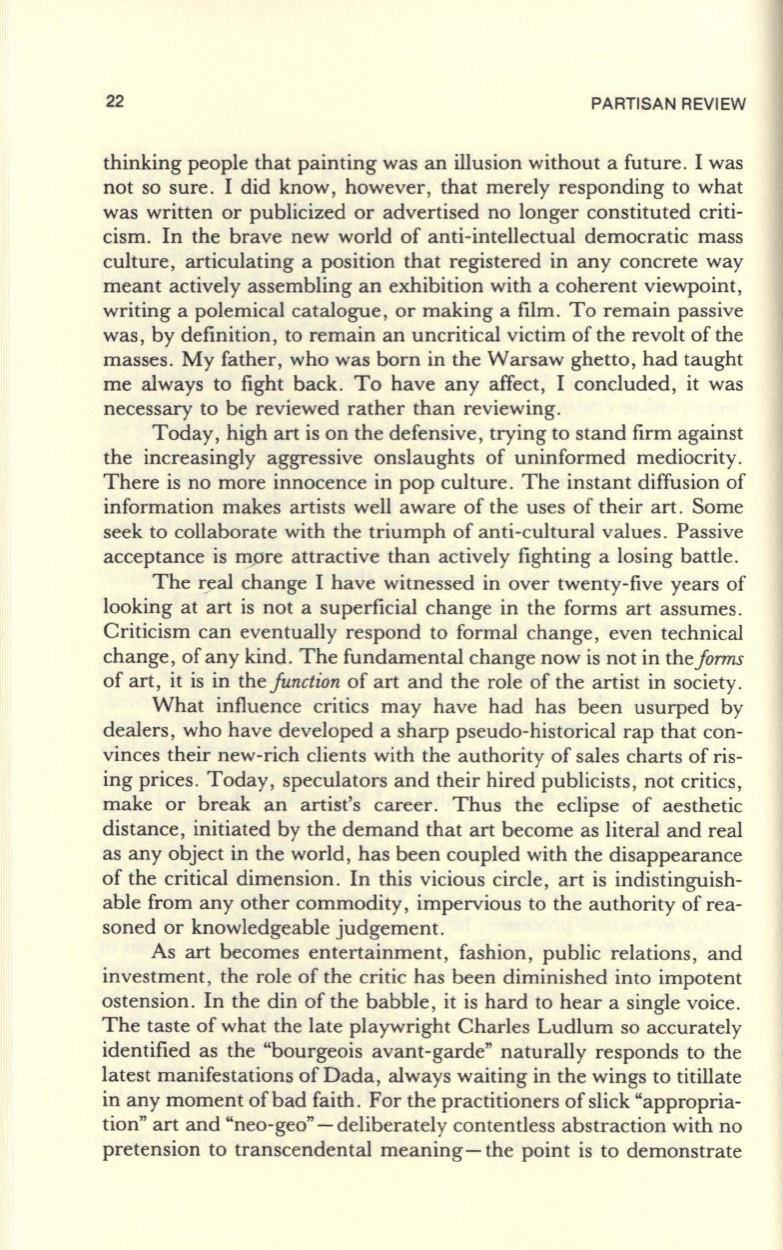
22
PARTISAN REVIEW
thinking people that painting was an illusion without a future. I was
not so sure. I did know, however, that merely responding to what
was written or publicized or advertised no longer constituted criti–
cism. In the brave new world of anti-intellectual democratic mass
culture, articulating a position that registered in any concrete way
meant actively assembling an exhibition with a coherent viewpoint,
writing a polemical catalogue, or making a film. To remain passive
was, by definition, to remain an uncritical victim of the revolt of the
masses. My father, who was born in the Warsaw ghetto, had taught
me always to fight back . To have any affect, I concluded, it was
necessary to be reviewed rather than reviewing.
Today, high art is on the defensive, trying to stand firm against
the increasingly aggressive onslaughts of uninformed mediocrity.
There is no more innocence in pop culture. The instant diffusion of
information makes artists well aware of the uses of their art. Some
seek to collaborate with the triumph of anti-cultural values. Passive
acceptance is mpre attractive than actively fighting a losing battle.
The r>al change I have witnessed in over twenty-five years of
looking at art is not a superficial change in the forms art assumes.
Criticism can eventually respond to formal change, even technical
change, of any kind . The fundamental change now is not in the
forms
of art, it is in the
function
of art and the role of the artist in society.
What influence critics may have had has been usurped by
dealers, who have developed a sharp pseudo-historical rap that con–
vinces their new-rich clients with the authority of sales charts of ris–
ing prices. Today, speculators and their hired publicists, not critics,
make or break an artist's career. Thus the eclipse of aesthetic
distance, initiated by the demand that art become as literal and real
as any object in the world, has been coupled with the disappearance
of the critical dimension. In this vicious circle, art is indistinguish–
able from any other commodity, impervious to the authority of rea–
soned or knowledgeable judgement.
As art becomes entertainment, fashion , public relations, and
investment, the role of the critic has been diminished into impotent
ostension. In the din of the babble , it is hard to hear a single voice.
The taste of what the late playwright Charles Ludlum so accurately
identified as the "bourgeois avant-garde" naturally responds to the
latest manifestations of Dada, always waiting in the wings to titillate
in any moment of bad faith. For the practitioners of slick "appropria–
tion" art and "neo-geo" - deliberately contentless abstraction with no
pretension to transcendental meaning- the point is to demonstrate


